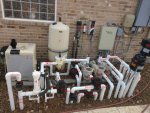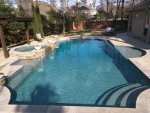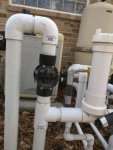Recently bought the house and trying to use BBB and understand the flow and parts. I already replaced a check valve, but I want to understand more. There are some labels on the equipment and I've recreated those labels in the picture.
Question #1:
I suspect my pool has a small leak as my auto fill stays on 24/7. Which valve in this system should I check first if I suspect such a leak? I already replaced check valve #9 and that fixed spa draining into pool.
Question #2:
What is this Del Ozone system (parts #14, 15, 16) and how does it integrate with the BBB method?
Question #3:
Should I replace part #15 annually?
39,000 gallon Pebble Tec, chlorine, spillway hotub, 4 main drains, 2 skimmers
1- Pentair FNS Plus 60
2- heater
3- multi-valve
4- auto chlorinater
5- 3-way valve (pool suction)
6- 3-way valve (skimmers)
7- ???? (valve of some sort)
8- ???? (valve)
9- check valve (why is this here...replaced recently)
10- booster pump (Pentair LA01N)
11- pool pump (Pentair 011018, 3HP variable speed...RPM:450-3450)
12- spa pump (Pentair WF-28)
13- water feature pump (Pentair WF-28)
14- Del Ozone - Mixing Degas Vessel
15- Del Ozone - ??? (part number 9-0620...says "replace 1 year from date marked")
16- Del Ozone generator (Eclipse 2)
17 and 18- blower silencers
19- check valve (why is this needed here?)
Question #1:
I suspect my pool has a small leak as my auto fill stays on 24/7. Which valve in this system should I check first if I suspect such a leak? I already replaced check valve #9 and that fixed spa draining into pool.
Question #2:
What is this Del Ozone system (parts #14, 15, 16) and how does it integrate with the BBB method?
Question #3:
Should I replace part #15 annually?
39,000 gallon Pebble Tec, chlorine, spillway hotub, 4 main drains, 2 skimmers
1- Pentair FNS Plus 60
2- heater
3- multi-valve
4- auto chlorinater
5- 3-way valve (pool suction)
6- 3-way valve (skimmers)
7- ???? (valve of some sort)
8- ???? (valve)
9- check valve (why is this here...replaced recently)
10- booster pump (Pentair LA01N)
11- pool pump (Pentair 011018, 3HP variable speed...RPM:450-3450)
12- spa pump (Pentair WF-28)
13- water feature pump (Pentair WF-28)
14- Del Ozone - Mixing Degas Vessel
15- Del Ozone - ??? (part number 9-0620...says "replace 1 year from date marked")
16- Del Ozone generator (Eclipse 2)
17 and 18- blower silencers
19- check valve (why is this needed here?)






